#disability as cyborg
Text


"They say racing drivers talk more and do less about sex than men in any other sport."... I treated her to a bitter smile. The playboy reputation, and its sarcastic flip side, is one we no longer deserve. Everything has become too competitive and commercial. Indeed the playboy image has all but expired.
"Formula Zero has rekindled our infamy," I explained. "New cars. New regulations. They want to rekindle the old magic. It's plastic. Packaged. Our sponsors twist incidents into publicity gimmicks. It sells ratings."
- "Grand Prix" by Simon Ings, Omni Magazine, June 1993
No one spends eight figures sterling on one man without some feeling behind it. Me? I get fresh ROMs sent me every month from Achebi where they analyze my race data. It helps me drive better. Only they went one stage further. They built me a second jack, behind my arse. When I strap myself in, I hotwire myself to the car. I don't drive it; I become it. This has consequences. My body is a corporate concern.
#f1#the more things change#data driven#sports entertainment#commercialization of athletes#seat of the pants driving#1990s#cyberpunk#speculative fiction#omni magazine#simon ings#disability as cyborg#many cw including#cw: crashes#cw: the whole typical suite of#dehumanizing and cringe biases#you'd expect of a white british dude of that time & milieu
1 note
·
View note
Text
Tips for writing and drawing Wheelchair using characters: Your character's wheelchair can tell us a lot about them
When you first start learning character design, you'll often be told something to the effect of "use your character's outfit to tell us more about them" - and this same principles can be applied to a disabled character's mobility aids.
Mobility aids like wheelchairs, to many disabled people, are a part of us. They can be an extension to a person's body and chances are, if you're going to be using this piece of equipment every day for the foreseeable future (or at least for a good amount of time for the foreseeable future), it's going to start reflecting some aspects of your personality, your interests, your passions, especially when you remember, a lot of people get their wheelchairs custom built for them.
You can use your character's wheelchair to tell us a lot about them without ever needing to show/describe them directly.
Let me show you two examples:

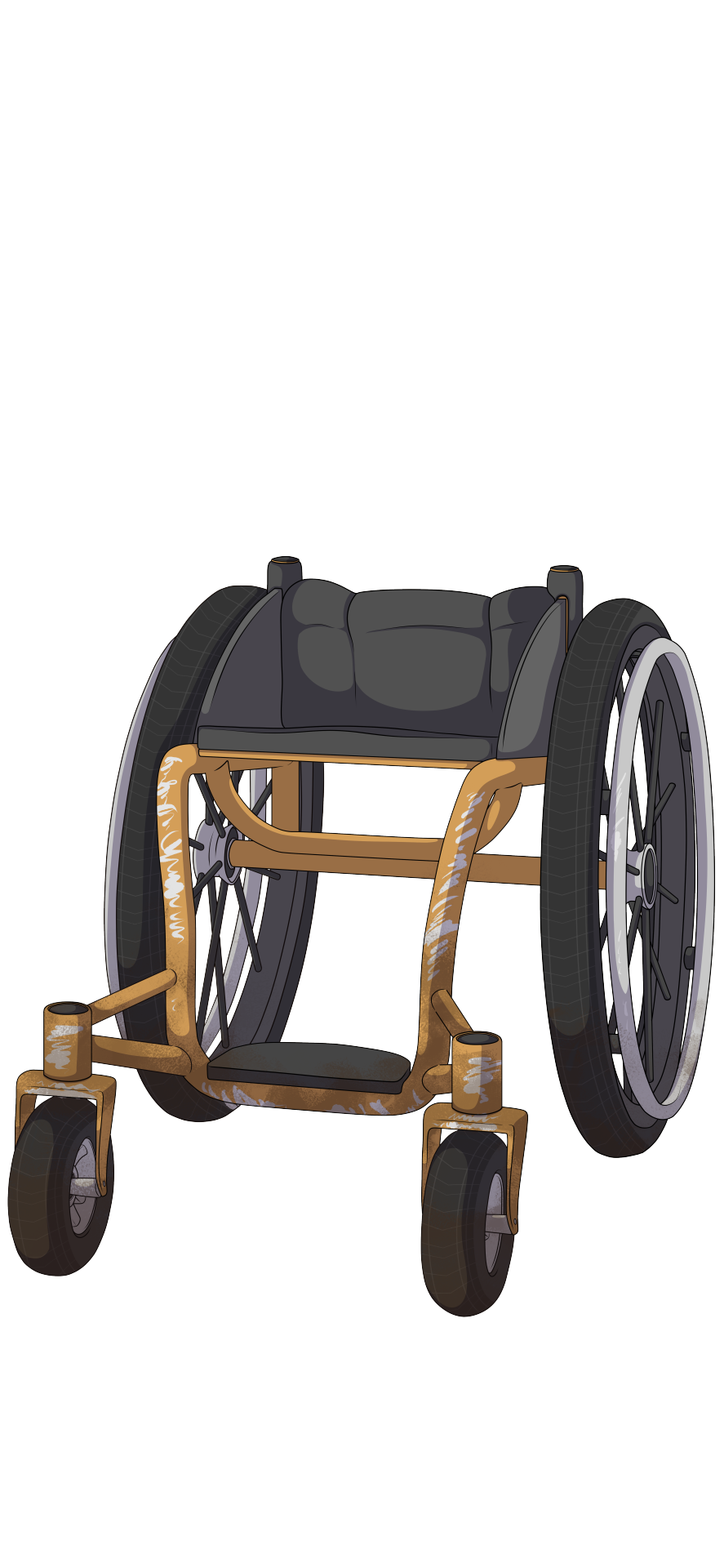
Take a look at these two wheelchairs. they're similar in shape and build, but still pretty different to each other. Can you make some guesses about their users based only on what's shown here?
intended answers below:
Please note, the following points are all generalisations and the real world is rarely this simple. This is to demonstrate how to use disability aids to contribute to your character's design, not how to make assumptions about real people in real life.
So here are some similarities between the chairs:
Both wheelchairs have ridged frames, this means the wheelchair can't be folded in any way. These kinds of chairs can imply a few different things depending on the person. They are typically lighter, sturdier and more durable, and indicate the person probably will be using the wheelchair for a long time and/or has the money to get something built to last (or lives in a place where cost not an issue due to universal/subsidised access to healthcare). They are also typically better to travel with when flying, as they are less likely to be broken by airport security/staff.
Both wheelchairs also lack anti-tip wheels, which are a third set of wheels that extend from the back of the chair. Them not being present could indicate the person is likely pretty confident in their ability to use the chair without worrying about tipping out. It could also indicate they are in an environment where the anti-tips could be more of a hazard than a help, such as on rough terrain.
So lets look at some specifics for the green wheelchair:
Take a look at the wheels. The front wheels are pretty small and appear to be solid, while the back wheels appear to be quite narrow (compared to the orange chair anyway). This indicates the user likely lives somewhere with decent accessibility like a (well funded) city where they are unlikely to encounter unpaved/dirt roads/grass. Small front wheels and thin back wheels are good for manoeuvrability and a smooth ride over even terrain, but they will get stuck as soon as bumps appear, so this probably isn't an issue for this person.
While its a bit hard to tell unless you have seen other similar wheelchairs, this wheelchair is very long in the front, meaning the footplate and front wheels are further away from the seat than most. There could be a few reasons for this. One either indicates the person has very long legs, or a lack of motion in their knees, making it harder to bend their legs. This is moves the chair's centre of gravity forward by a decent amount, making it harder to tip back, which could indicate the person's legs are very light. You tend to see this most often in the wheelchairs of bilateral leg amputees, who are at a greater risk of tipping backwards due to a lack of weight at the front of the chair (even if they wear their prosthetics).
The colour of the chair is bright. This could simply be the character's favourite colour, or maybe this colour has some significance to them?
There are stickers on the side of the chair relating to the Paralympics. This could indicate the person is a fan, or perhaps had some involvement in the games?
The wheelchair has handles on the back, but they are able to be folded down. This is a popular feature for people who are independent enough to go out on their own, but still want to have the option for some help. folding down the handles also deters random strangers from grabbing at you (an unfortunately common experience for wheelchair users).
There is some mild paint scratching to the front of the wheelchair, but nothing too noticable. This is typical of older chairs and people who are a little rough on their chairs. Maybe they've had a few stacks and falls throughout the years, probably going a decent speed.
Ok, now let's look at the orange chair
This wheelchair has very large, inflatable front wheels, and very thick back wheels. This will make the chair slower and less manoeuvrable on flat/even surfaces, but much, much easier to push on rough terrain. This is supported by the amount of mud on the wheelchair.
The seat on this wheelchair tilts upwards slightly. This is called a bucket (or according to an old basketball teammate of mine, a dump-truck lol). This is a feature you typically see in wheelchairs made for people with spinal injuries who are unable to move their legs and engage their lower bodies or core to help keep them stable.
The back of this chair is very low, indicating that if this wheelchair user has a spinal injury, it's probably pretty low on their spine, likely fairly close to the hips, making the person a low-level paraplegic. Higher-level paraplegics and quadriplegics usually need a higher back to help support them and keep them from flopping over, since all the muscles below their place where their spine broke either doesn't work, or is significantly weaker. Higher backs though can get in the way of pushing and reduce mobility, so people who need less support will likely opt for a lower back rest.
This wheelchair has no handles, which indicates the user is probably very independent and doesn't need a lot of help getting around.
The paint on this wheelchair is very scratched up, showing the person is very tough on their wheelchair and doesn't care to get the paint touched up.
This wheelchair has no breaks. This is very common on chairs with larger tiers as they don't tend to be as effective, but also on many outdoor wheelchairs, for two reasons. One is because they are made for rough terrain, so chances are, you aren't going to go far without a big push to get you moving. The second reason is that to get over large bumps and obsticals in a wheelchair, it can be helpful to do very large pushes using the top and front of the wheel. When pushing a normal chair, most people will only use the top section of the wheel to push since it's closest, but these big pushes that use the front of the wheel make it easier to push, since you can benefit from downwards momentum. However, this is also where the breaks are located on most wheelchairs, which can create a hazard. I've lost entire fingernails by them getting snagged on the breaks when pushing this way. So if you live somewhere where the breaks are not going to be helpful to you often, it makes sense to not get them.
And here are the characters who own these wheelchairs
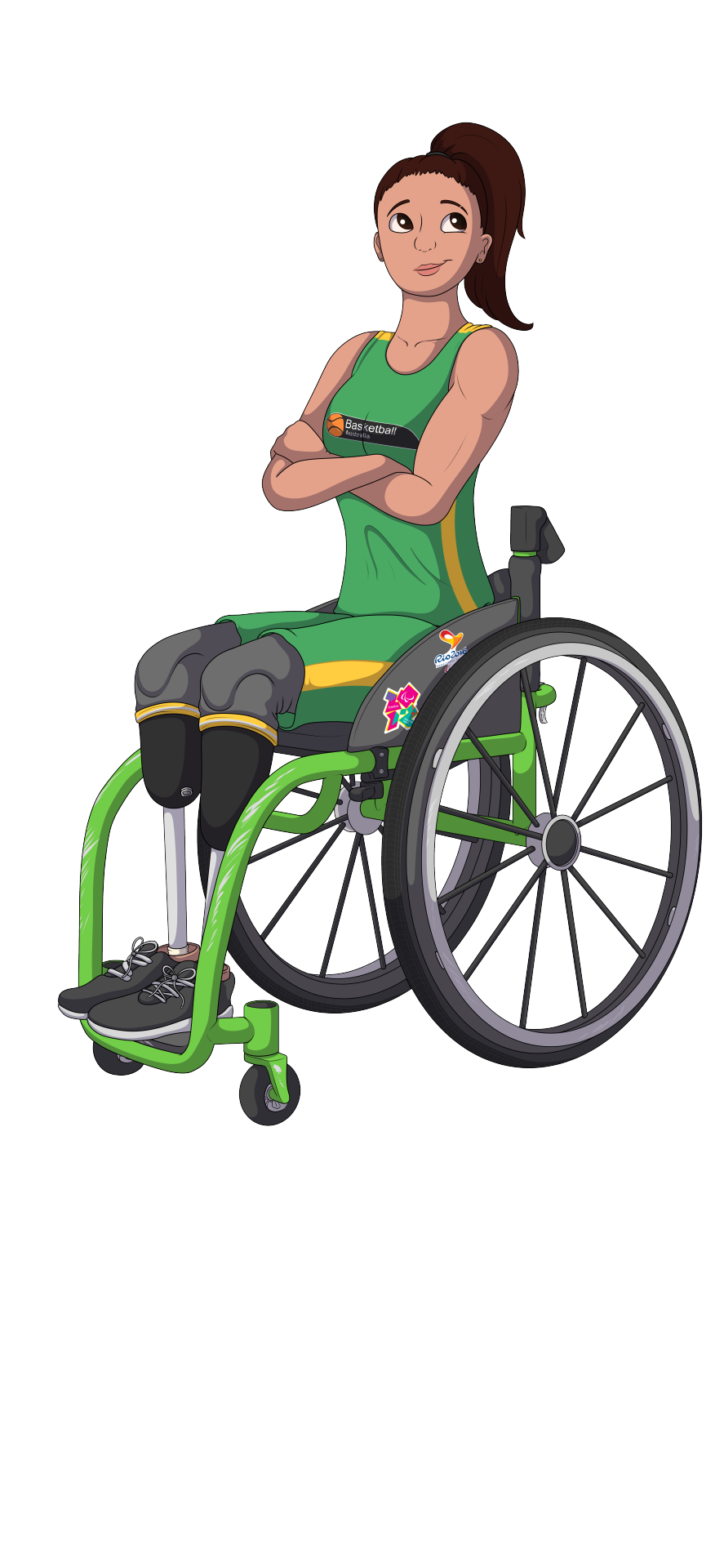
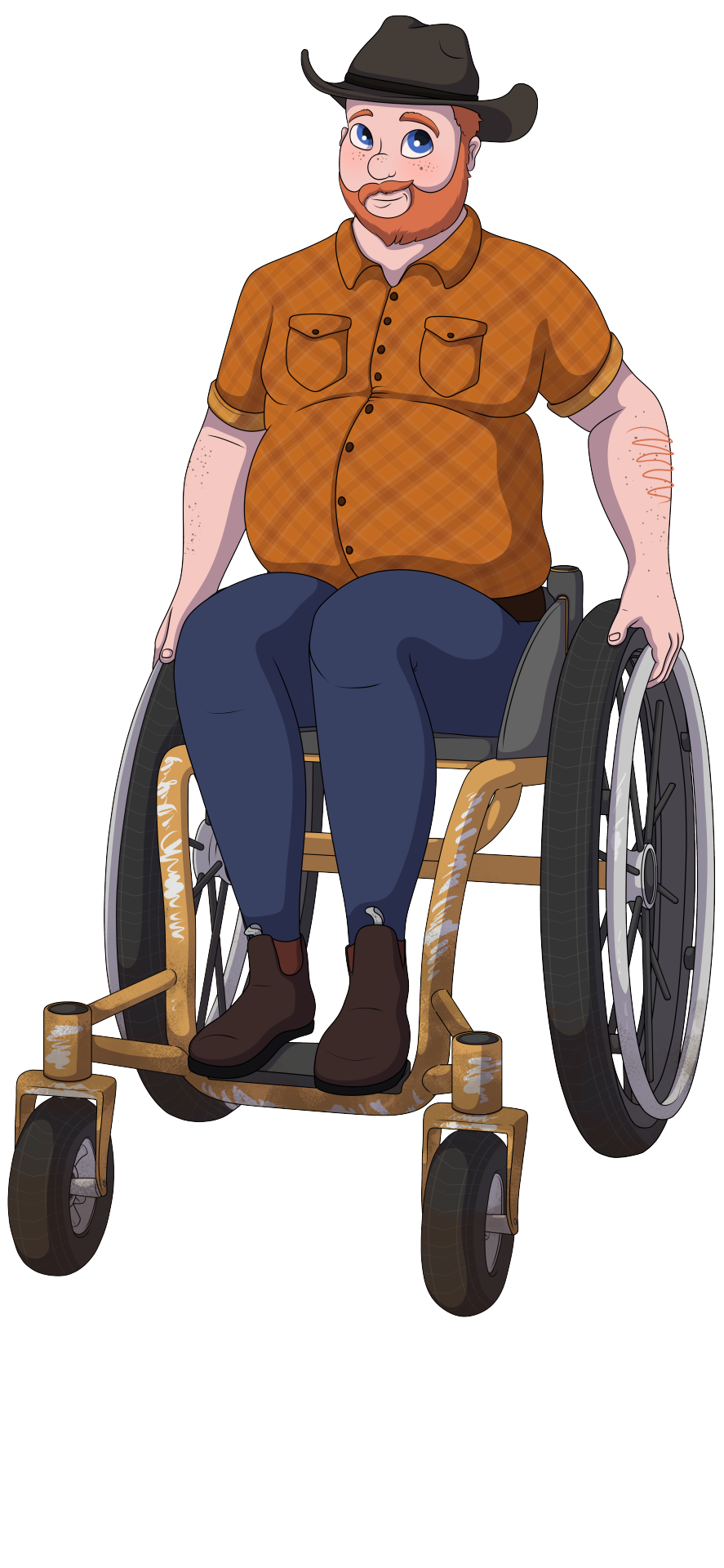
The owner of the green wheelchair is an amalgamation of a few people I knew from when I played wheelchair basketball. They're a bilateral leg amputee, and judging by their outfit (The Official National Wheelchair Basketball uniform for Australia), they're an elite athlete. This wheelchair is not the one they play sport in, but it still needs to be durable enough to withstand the rough treatment of airport staff when traveling, as well as heavy day-to-day use that comes with being an active person. While it needs to be rough, the person also seemed to want to prioritise speed and manoeuvrability, and likely doesn't need to worry about rough terrain too much, so they probably live in a major city.
The owner of the orange chair was inspired by a family friend of mine. They live on a farm, and need a chair that can handle life in those conditions, rough terrain and all. This comes at the cost of speed and manoeuvrability on smoother terrain, but honestly, anyone who's lived in the country knows you won't find many of those around there anyway, so that's not too big of a sacrifice. They are paraplegic, are very confident in their ability to use their wheelchair, and probably doesn't need help too often, but still benefit from some extra stability support from the raised seat on their chair.
Conclusion
Once again, these are generalisations, and in real life there are always exceptions, but I hope this helped demonstrate what I meant when I said you can use your character's wheelchair to tell us more info about them if you're smart about it.
I originally planned to do a whole series of these, showing a wider variety of wheelchairs and the people who they belong to, but I guess I kind of forgot because they've been sitting, abandoned on my hard drive for the last 2 years 😅. If that's something you folks would be interested in seeing though, let me know, I'd happily revive the series lol.
#Writing Disability with Cy Cyborg#id in alt text#long post#writing disability#disability#disabilities#disabled#physical disability#wheelchair user#physically disabled#wheelchair#character design#character illustration#character concept#Designing Disabled Characters#writers on tumblr#writing#writing community#writblr#writerblr#writing advice#writing tips#writing resources#art reference#artists on tumblr#artblr#illustrator#visibly disabled#disabled and proud
4K notes
·
View notes
Text
Less technology used for evil, more of this shit
vimeo
#hope posting#cyborg#cybernetics#transhumanism#disability#physical disability#actually disabled#biopunk#cyberpunk#not an action#Vimeo#science and technology#art#I don't even know what to call this kind of art but this IS art#experimental art
197 notes
·
View notes
Text



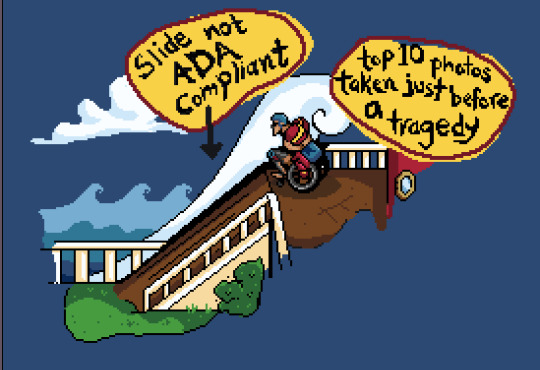
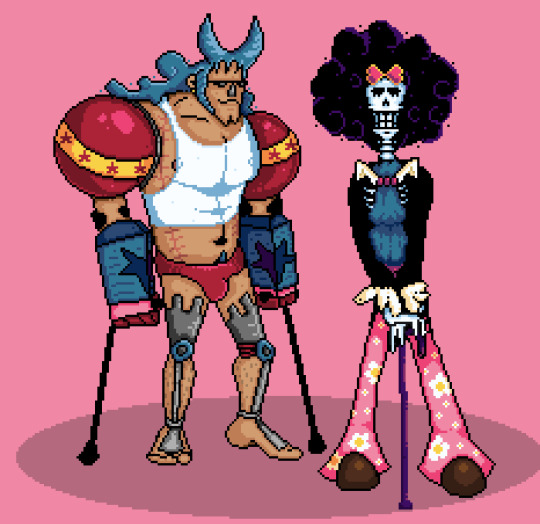
Hey bros, does turning the bottom half of your legs into tracked treads count as an assistive mobility device?
Sketch dump from an old unfinished series I like to call "One Piece AU in which everything is the same but we let the quadruple amputee go at his own pace for a goddam second"
He knows all the tricks. But he should have made the grade on that ramp slide a little less steep.

#him hands so big to hold his forearm crutches of course#uh don't look at that brook too close it was my very first try at drawing him#thats actually not an excuse these were my very first franky studies too#i was like let me try and draw something hard and then I'm going to put him in a chair which is also notoriously hard to draw#i just think hes neat#one piece#cyborg franky#soul king brook#straw hat pirates#disability positivity#i do not personally have a mobility disability but these were a fun study for me#my art
308 notes
·
View notes
Text
Do You Know This Disabled Character?

Murderbot has social anxiety and Post Traumatic Stress Disorder
#poll#polls#disability#disabled characters#id in alt text#murderbot#I love it very much#I would like to note that technically Murderbot is not a cyborg#it is a construct#as a cyborg is a human with mechanical parts (for a simple definition)#and Murderbot is not human#y’all should go read All Systems Red I really liked it and I don’t particularly like reading sci-fi#mod a was summoned from the void to write tags for once
108 notes
·
View notes
Text



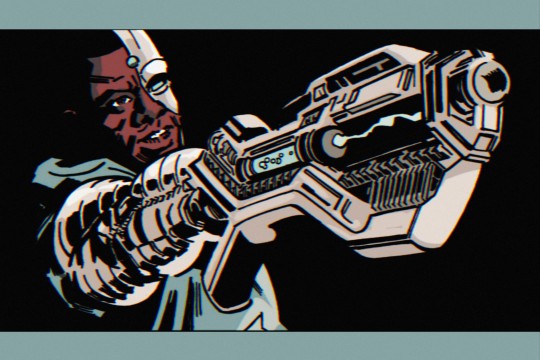
I wondered if I'd lost my soul, even my identity, by becoming a machine--and maybe even a monster. But I wasn't a monster. I was who I'd always been.
#dc comics#cyborg#victor stone#dcedit#dccomicsedit#comicedit#comicbookedit#my edit#my stuff#dailydcheroes#dailydccomics#disabled characters#dcmultiverse
247 notes
·
View notes
Text
It’s been over a year since my surprisingly popular Twitter posts on disabled DC heroes, and surprisingly, some stuff is better. Jericho hasn’t appeared in a bit and Oracle is STILL treated awfully, but there’s some improvements otherwise.
Here are the posts, I’ll explain the improvements below them:



First, Cyborg’s got a solo series written by a disabled author, and has been treated well both there and in the wider universe.
Second, Capt Marvel Jr is currently unpowered, but that means his disability is more visible in the current Shazam series.
Third/Last, Batgirl’s language skills are being written more consistently with how they used to be, which better reflects her established disability.
#dc comics#dc#jericho#joey wilson#oracle#barbara gordon#cyborg#vic stone#captain marvel jr#freddy freeman#batgirl#cassandra cain#disability
182 notes
·
View notes
Note
hey, would you be able to give a brief description/explanation of cyborg theory in disability? I tried looking it up but didn’t find anything
absolutely! been struggling a bit with cognition so i’m just gonna paste the relevant section from my essay on disability & technology from about a year ago + the full citations of pieces i reference. hope this helps - feel free to send me a follow up ask if there’s anything else you’re looking for or with your thoughts, & folks are welcome to dm me for the full essay if you want!
One key concept employed by disability studies scholars to explore the relationship between humans and technology is that of the cyborg. Originally developed by Donna Harraway in the 1980s, the cyborg is a figure which “[blurs] the boundaries between human and animal, machine and organism, physical and non-physical” (Kafer, 2013, p.103) and in doing so allows for nuanced discussions of technology beyond the common dual responses of uncritical praise and unlimited fear. Though Harraway’s initial theorization positioned “disability as the site of spectacular technological fixing” (Kafer, 2013, p.112), feminist disability studies scholars have expanded the concept to more fully reflect disabled people’s experiences.
At their best, cyborg subjectivities prompt us to recognize—rather than dismiss—“the inequitable ways in which many people come to disability” (Hamraie and Fritsch, 2019, pp.19-20). War, poverty, pollution, and other consequences of colonisation and exploitation are major causes of impairment among marginalised communities (Meekosha, 2011; Erevelles, 2011), making concepts such as disability culture and pride difficult or undesirable for many people. Not only are the bodies of workers in the Global South disabled by the production of “assistive technology,” as discussed previously, the bodies of marginalised people, especially poor women of colour, are disabled by medical testing (Hans, 2006). While Erevelles questions the value of cyborg subjectivities in the face of these harrowing realities (2011), Kafer argues that their power lies in this very tension (2013). The cyborg, she writes, “refuses easy celebrations of human/technology connections” (Kafer, 2013, p.118) and rather encourages us to confront our complicity in the structures of oppression we seek to resist.
Erevelles, N. 2011. Disability and difference in global contexts: enabling a transformative body politic. New York: Palgrave Macmillan.
Hamraie, A. and Fritsch, K. 2019. Crip technoscience manifesto. Catalyst: Feminism, Theory, Technoscience. 5(1), pp.1-34.
Hans, A. 2006. Gender, technology and disability in the South. Development. 49(4), pp.123-127.
Kafer, A. 2013. Feminist, queer, crip. Bloomington: Indiana University Press.
Meekosha, H. 2011. Decolonising disability: thinking and acting globally. Disability & Society. 26(6), pp.667-682.
442 notes
·
View notes
Note
Can you draw Cynder X Peril?
I was not expecting my first piece of fanart for a wings of fire character to be shipping one of them with a Spyro character, but here we are lol. Shipping the two "edgy" moody dragon girls sounded like too much fun not to do though. They're lesbians now, I don't care what cannon says.

I've been on this site for less than 2 months and I'm already doing unusual ship art that I spent way too much time on lmao
The backgrounds are from the Clip Studio Paint Library.
Also putting a disclaimer here becuase I made the mistake of getting involved in the Cynder shipping wars back in my Deviantart days, this was a joke, I think both their cannon ships are adorable lol
#id in alt text#cy cyborg draws#they're gay and in love#disabled artist#queer artist#my art#dragon#cynder the dragon#spyro the dragon#dragon art#tlos cynder#cynder#the legend of spyro#spyro fanart#legend of spyro#tlos#peril#peril wof#wof#wingsoffire#wings of fire#wings of fire art#wof fanart#wof art#wings of fire fanart#shipping art#ship art#shipping#digital art#cute
87 notes
·
View notes
Text
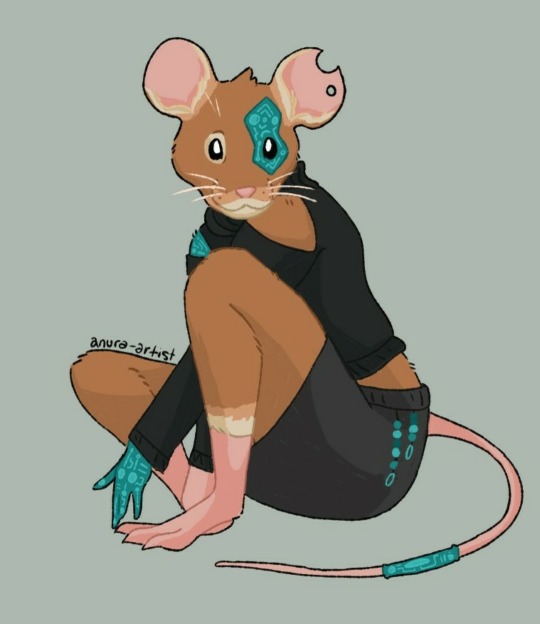
Hi, I'm Elf! 🖌️
I'm a 20 y/o artist from the US. I'm also a queer 🏳️🌈 & disabled college student minoring in art!
I follow & interact from @elflikesfrogs . I also have a gaming blog, @anura-island !
This is my fursona, Digit the cyborg mouse! 🐀 I have two other fursonas currently, Analog the wolf 🐺, and Red the dragon 🐉!
Digital art
Paintings
Fanart
OCs
Fursonas
(I will add the links later I just wanted to get this posted soon since I'm getting so much support on my Red drawing. Thank u so much btw ily all!!!!!! 💖💖💖💖💖💖💖 (✿^‿^))
Commissions info 🎨
^ to be linked later once I make a comprehensive post 😵💫 but the basics are, commissions are open! I love drawing people, OCs, fanart, fursonas, whatever! My prices are pretty reasonable! I'm open to almost anything! DM me!
Please do not repost my works, but reblogs are incredibly appreciated! Likes and comments are also appreciated! Or just smile fondly at my work. That's appreciated too ( ◜‿◝ )♡
I will only be posting SFW art here 🌸
Thank u so much for reading, ily!!!
~🌸~🌺~🌼~🪷~🌷~🪻~🏵️~🌻~🌹~
#art#my art#artists on tumblr#artwork#fursona#digital art#digit the cyborg mouse#furry#furry art#furry sfw#furry oc#sfw furry#furry mouse#anthro mouse#mouse oc#anthro#queer artist#disabled artist#commisions open#pinned post
21 notes
·
View notes
Text
This is just a not-so friendly reminder to non-disabled people, especially authors, people in fandoms or in media analysis circles: Cripple/crippled is not just a fancy way of faying "badly injured". it's not an adjective you can just throw in to spice up your sentence because you used "injured" or "disabled" too many times in that paragraph, or because you feel like it gives your writing some extra "oomph".
Cripple is a slur.
A slur the physically disabled community has been asking people not to use for DECADES, since at least the 1970's (50 years). It's a slur with centuries of abuse behind it, centuries of being used to justify physically disabled people as less-than, centuries of demonisation, mistreatment, ostracization, and murder.
Some people within the physical disability community are reclaiming it, that's where movements like cripplepunk (also known as crip-punk or C-punk) come from. That's fine, I'm not talking about that. I love the cripplepunk movement and everything it stands for: being unapologetic about our disabilities and not changing ourselves for the comfort or convenience of able-bodied folks. But the people who use it in that context understand the history of the word, they know how it was used to hurt us, and they understand that not everyone in the physically disabled community is comfortable with the use of the word, especially those who were around when someone being labelled as "crippled" was seen as a valid reason to treat them as less than human. They understand the impact of the word.
But If you, as an able bodied person, casually uses "cripple" in your work, at best you are showing your disabled audience that you haven't been listening to us, at worst, you show you don't care about weather we feel safe in the spaces you have created.
And for able-bodied authors specifically, even if your character is physically disabled, I'd still recommend avoiding it unless you're prepared to do a LOT of sensitivity readings from multiple sensitivity readers. I've been physically disabled since I was 1 year old, I learned to walk for the first time in prosthetics and have been using a wheelchair since I was in school, I have no memory of life as an able-bodied person, and even I don't feel comfortable using the word cripple in my work.
It's a loaded word, with a lot of implications and a LOT of very dark, and for some people, very recent history. It's not a sentence enhancer to just throw in willy-nilly. Please.
#Writing Disability with Cy Cyborg#disabled#disability#disability history#ableism#physically disabled#cripple punk#cpunk#actually disabled#physical disability#visibly disabled#visible disability#writing disability#writing#writing community#writeblr#writers of tumblr#authors of tumblr#media analysis#write#c slur#language
3K notes
·
View notes
Text
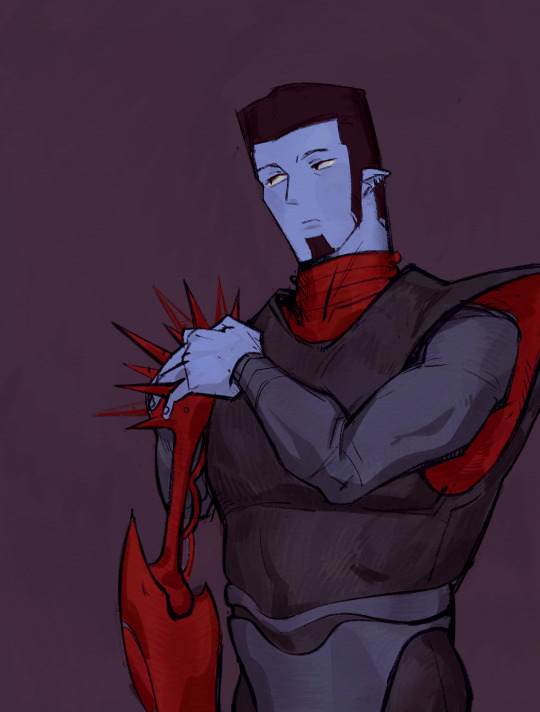
cumbersome and heavy body
#warp darkmatter#buzz lightyear of star command#hi everyone can we talk about warp ive been dying to talk about warp#like... thinking about how hes canonically disabled. he is missing a hand!!! that is so important to me and i think about it a lot#yes hes all that primadonna girl bubblegum bitch electra heart etc . but also he is an amputee! and that makes him so interesting to me..#i love to think about how a guy like warp deals with the missing of a hand both in the lost-it-during-tab and lost-it-in-the-past scenarios#like how much time it took him to adjust or how he went through physiotherapy with gritted teeth. THINK ABOUT IT!#he loves to put up fronts and be that suave arrogant kinda guy but also has chronic pain and takes off his stupid hand first chance he gets#so its interesting to consider eg how much itd take him to admit that his bitchin hand is also stupid and heavy and he gets tired...#not to romanticise disability btw it just gives him delicious dimension and . you know!!!!#i wish it was explored more in the fandom lol i know it gets swept under the rug bc of scifi perfect bionic cyborg limbs fantasy#but i want more content of warp sans his hand... just doing mundane shit... living his life... representation..!#and not like 'warp lives and sleeps with his prostetic and it feels natural to him ^_^' dont erase his disability!!!!!!!#drawpost#origpost#also his suit is fucked in this art LOL my pipeline for this piece was horrid. dont ask me about my layers im deeply ashamed.
39 notes
·
View notes
Text
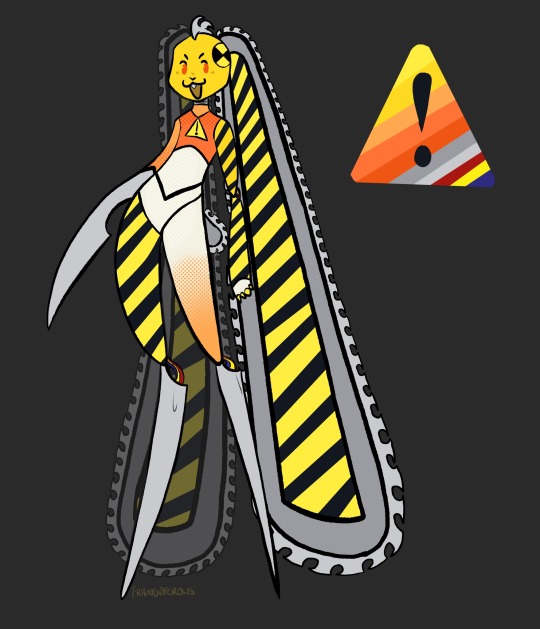
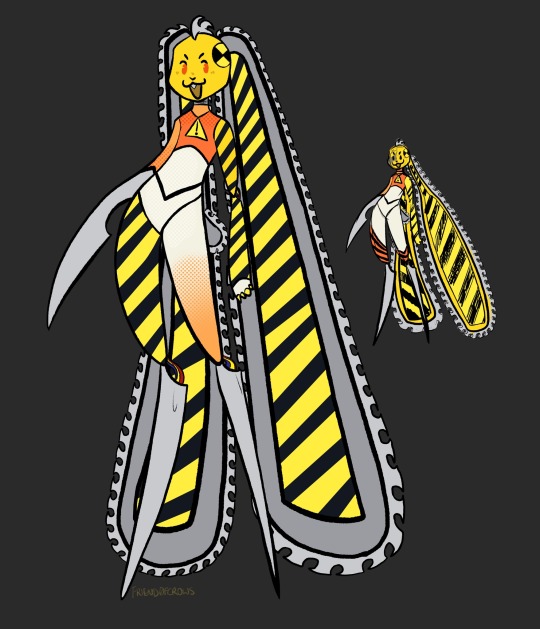
*inhale* ⚠️test dummy chainsaw cyborg rabbit⚠️
#theyre up for sale#oc#anthro#original character#furry#disabled artist#character design#chainsaw#warning#cyborg#robot#rabbit#bunny#test dummy
25 notes
·
View notes
Text
youtube
Teen Titans is a source of a lot of fond nostalgia for me, but it did not always hit the mark.
65 notes
·
View notes
Photo




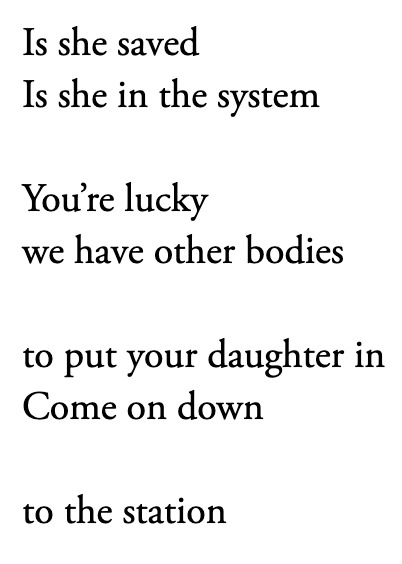


the body and the self
alan watts / ocean vuong / bodys, mother mother / body terror song, ajj / future biometrics, the cyborg jillian weise / bad road, leah lakshmi piepzna-samarasinha / in whch he attempts to breathe, travis chi wing lau
#the body#the self#disability#body#alan watts#ocean vuong#bodys#mother mother#body terror song#ajj#future biometrics#the cyborg jillian weise#bad road#leah lakshmi piepzna-samarasinha#in which he attempts to breathe#travis chi wing lau#song lyrics#poetry#queue.#my post.#answered ask#@wormwoodswork#thanks for the ask!
74 notes
·
View notes
Text
Thinking of Vic's complicated relationship with his body due to the circumstances that lead to him having his cybernetic prostheses being extremely traumatic and out of his control and waking up suddenly in a body that feels unrecognizeable to him --
but slowly learning to accept himself first by hanging out with people who are 'freaks' like him (the new teen titans) and then other disabled people IRL who do not view his protheses as weird but rather cool (the kids at sarah's school).
But anyway I'm wondering if there's a stage where Vic begins to be glad for his cybernetic body -- not how he got it, that killed his parents so he would not be glad for that. but while initially he was understandably mad at his dad for the extreme body modifications he had no say in*, I wonder if later on he would be glad for it because. his parents died. They're both gone. But they both** contributed to the technology that keeps Vic alive, their work is in him, they help him protect himself even when they're no longer there and there will always be some reminder of their love for him in him.
*which I don't think is really inherently wrong of Silas to do, because Vic was fucking dying and it was the only way to save his life, but it is understandable that at first Vic sees this as something that was done to him, not for him.
**initially it was just his dad, but IIRC later comics retconned it so his mom contributed some research to the tech that keeps him alive. EDIT: Ty @danny-chase it was Elinore Stone (Vic's mom) who built cybernetic protheses for the army which was implied to be in her mind something to help dismembered victims of war, the army wanted a perfect soldier with it. NTT (second series) #47
#victor stone#cyborg#dc comics#the new teen titans#teen titans#disabled characters#silas stone#elinore stone
190 notes
·
View notes